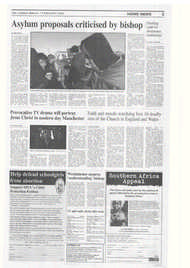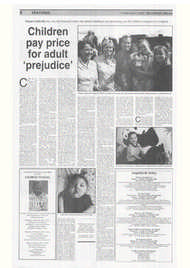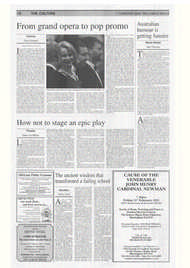Page 7, 7th February 2003
Page 7

Report an error
Noticed an error on this page?If you've noticed an error in this article please click here to report it.
Tags
Share
Related articles
D Eacon Concession
Is Our Church Rejecting True Priestly Vocations?
Vatican Makes Overture To Lefebvrists
Speculation Mounts Over 'universal Indult' To...
Econe Open
Traditionalists: the Church's future?
There is a vocations crisis at the Fraternity of St Peter. It has too many applicants for their seminaries. No, it's not a misprint. It has too many applicants. Not only that, the Fraternity has just built two seminaries, one in Wigratzbad, Germany, and another in Lincoln, Nebraska in the United States, where new facilities are currently under construction to increase further the number of places available.
The Fraternity of St Peter (FSSP) was founded by the Holy See in 1988 to preserve the traditional Mass of the Roman Rite, or the Tridentine Rite as it is more commonly known. FSSP priests therefore celebrate Mass and the other sacraments according to the Missal of 1962 and not the Missal promulgated by Pope Paul VI in 1970. At the time of the founding of the FSSP, Pope John Paul II wrote: "Respect must everywhere be shown for the feelings of all those who are attached to the Latin liturgical tradition, by a wide and generous application of the directives already issued some time ago by the Apostolic See, for the use of the Roman Missal according to the typical edition of 1962."
In 1988, the FSSP had nine priests and 20 seminarians. Now, in 2003, it has 130 priests and 127 seminarians. We hear all the time that vocations are drying up and seminaries closing. But the FSSP has just expanded its facilities and still can't accommodate the numbers of young men applying to train for the priesthood. What's more, the FSSP is funded entirely by lay donation, an indication not only of the determination of those attached to the Latin liturgical tradition, but of their growing numbers.
In 1988, the Holy Father also wrote: "To all those Catholic faithful who feel attached to some previous and disciplinary forms of the Latin tradition I wish to manifest my will to facilitate their ecclesial communion by means of the necessary measures to guarantee respect for their rightful aspirations. In this matter I ask for the support of the bishops and of all those engaged in the pastoral ministry of the Church."
Despite the The Holy Father's call for measures that respect the "rightful aspirations" of those attached to the Old Rite, it can seem at times that those who wish to exer
cise these aspirations are frequently ignored or marginalised, and this results in them being largely excluded from mainstream parish life. The response of the bishops has been mixed, to say the least. In one English diocese the "necessary measures" amount to granting permission for one Old Rite Mass, once a month, for the entire diocese.
In the United States and Canada, the FSSP has, in some dioceses, been granted what are termed "extra-territorial parishes", which are not limited in territory but are parishes in the sense that they are open to anyone in the diocese who prefers the old liturgy.
The first of these parishes was in Ottawa, Canada, and the second in Scranton, Pennsylvania. The FSSP also has chaplaincies in Corpus Christi, Texas; Lincoln, Nebraska; Vienna, Ohio; Elmhurst, Pennsylvania; Atlanta, Georgia; Indianapolis, Indiana and Tulsa, Oklahoma. In Europe, the FSSP has extra-territorial parishes in Stuttgart, Germany, and in Salzburg, Austria, and FSSP priests have established chaplaincies throughout Europe as well as in Australia and Nigeria.
In England, Archbishop Vincent Nichols of Birmingham has given permission for the establishment of a Mass centre served by Fr Andrew Southwell, who is affiliated to the FSSP. This is based at the West Oxford Community Centre, Botley Road, Oxford, and Fr Andrew commutes to Oxford every week from London to celebrate Sunday Mass for the traditionalist community there. Fr Andrew is based at St Bede's, Thornton Road, Clapham Park, London, where an Old Rite Mass was already established, at 7.00am on Sundays. Recently Archbishop Michael Bowen of Southwark gave permission for another FSSP priest, Fr Armand do Malleray, to be based at St. Bede's, and now there is a daily 7.00am Old Rite Mass and an additional 10.45am Sunday Mass, all with the cooperation of the parish priest there.
While these are considered to he significant developments by the FSSP, they also give some indication of the difficulties laced by those who are attached to the Latin liturgical tradition in this country and across the world. Many priests live an almost peripatetic existence which requires extensive travelling in order to serve communities attached to the Old Mass.
"We need our own churches," says Fr Andrew, "where we can offer all the sacraments according to the 1962 Missal and where people can have the benefits of parish life."
The Latin Mass Society, which was founded in 1965 for the preservation of the Roman Rite as one of the legitimate forms of the Church's liturgy, has had to withstand decades of indifference, if not hostility, to its work of making the Old Rite available to the laity.
According to the LMS, critics either point out that the traditionalists have nothing to complain about because there are Tridentine Masses available for those who want them, or they insist that the Old Rite attracts only a tiny minority of the Mass going population who haven't moved with the times.
Due to the longstanding work of the Latin Mass Society in this country, and the support of Massgoers, Tridentine Masses are increasingly available, with the establishing of the FS SP in this country being an important part of the overall picture. But as anyone who has ever looked for an Old Rite Mass in a strange town will know, they are notoriously difficult to find. I once asked in an abbey shop if anyone knew of an Old Rite Mass in the locality and a deadly hush descended on the room as if something unmentionable had been said.
Old Rite Masses are rarely announced on church noticeboards or in parish newsletters and tend to be at awkward times of the day, for instance 3.00pm on a Sunday when everyone is having lunch, or 6.30pm on a Friday, when the rush is on to get home for the weekend. And the provision of an Old Rite Mass on the first Saturday of the month at 4.00pm, or the last Sunday of the month at 9.00am, can only discourage all but the very dedicated.
The fact that 15,000 people gather each year at Pentecost for a traditional pilgrimage from Paris to Chartres, which involves camping out for two nights and concludes with a Pontifical Mass in Chartres Cathedral according to the 1962 Missal, is hardly known outside traditionalist circles. In 2001, the concluding Mass was celebrated by Cardinal Medina Estevez, prefect of the Congregation for the Clergy.
Hardly known, too, is the existence of the Institute of Christ the King Sovereign Priest (ICKSP), which is also dedicated to the preservation of the traditional Roman Rite. The institute was established in 1990 at the suggestion of Cardinal Mayer and currently has more than 40 priests, 60 seminarians as well as apostolates in Europe, the US, Gabon and Brazil. Their seminary at Gricigliano, near Florence, is also funded by lay donation and among their traditionalist parishes in America is St Mary's, Elm Street in Rockford, Illinois and the Church of Old St Mary's in Washington DC.
Similarly, few have heard of the newly built Abbaye St Madeleine du Barroux in the south of France, which is entirely Old Rite. The abbey houses some 60 monks and was given canonical status in 1989, with the abbey church being consecrated by the Archbishop of Avignon in the same year.
Few also know that there are numbers of priests in New Rite parishes who would like to celebrate Mass according to the Missal of 1962. The Priestly Society of St John Fisher was established eight years ago to support diocesan priests who wish to celebrate the Old Rite and to help those priests trained in the New Rite learn about the Old Mass.
The picture seems contradictory. Those attached to "some previous form of the Latin tradition" are often marginalised, almost ignored and frequently derided by the liturgical establishment. And yet, the traditionalist movement is one of the significant growth areas in the Church. The fact that Old Rite Masses have to be sought out means that many people are not even aware of their existence. It is difficult to come across one by accident and hardly possible to visit a church and discover by chance that an Old Mass is being celebrated there. "There is only one thing in the world worse than being talked about, and that is not being talked about," Oscar Wilde once said. The traditionalist movement seems to suffer on both counts.
Apparently contradictory, too, is that while traditionalists are often accused by their critics of being stuck in the past, increasing numbers of young people are becoming attached to the Latin liturgical tradition. A glance at an Old Mass congregation reveals that that least half of those attending are too young to have known the Church in her pre-Vatican II days. This is a trend that seems to be growing, as is the number of vocations to the priesthood that the Old Rite seems to inspire. In an age which is facing a shortage of priests and in which there is talk of parishes closing or having to merge, both the FSSP and the ICKSP have priests available to send to this country. In the present situation, young priests from Britain who have been trained at FSSP and ICKSS seminaries cannot expect to be offered a parish here and are being sent abroad to fulfil their ministries.
It is often claimed that the existence of more than one Rite in the Church and in individual parishes could cause division and lead to friction developing between their respective communities. But according to Cardinal Ratzinger: "One has to realise that several forms of the Latin Rite have always existed ... Up to the Council there existed alongside the Roman Rite, the Ambrosian Rite, the Mozarabic Rite of Toledo, the Rite of Bragga, the Rite of the Carthusians and the Carmelites, and the best known, the Dominican Rite and perhaps others which I do not know.
"Nobody was ever scandalised that the Dominicans, often when present in parishes, did not celebrate like parish priests but rather had their own rite.
"We have no doubt that their rite was both Catholic and Roman. We were proud of the richness of having several rites."
Wherever you stand on the argument over new versus old, what must be obvious is that there is something utterly "other" about the traditional Roman Rite. When boundaries are dissolved and distinctions eliminated, there's always a danger of being swamped by external influences. The form of many New Rite Masses is sometimes barely distinguishable from a secular celebration that might take place in a park or at a dinner party.
The traditional Roman Rite clearly has the capacity to draw people to it, in an age when the general drift in the West is away from the Church. On the 10th anniversary of the Motu Proprio Ecclesia Dei, Pope John Paul 11 announced: "I invite the bishops also, fraternally, to understand and have a renewed pastoral attention for the faithful attached to the Old Rite."
While there are some very small signs that this is beginning to happen, much more could surely be done.
The FSSP newsletter is available from Fr John Emerson, 6 Belford Parlc, Edinburgh, EH4 3DP
blog comments powered by Disqus















